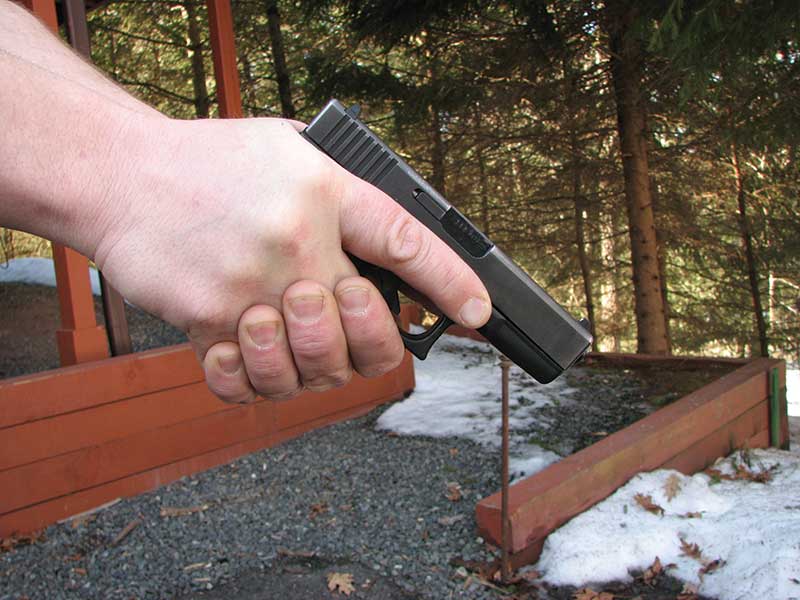Low-Ready Is Ready
When challenging a suspect, muzzle-down is no handicap
Because I’m a glutton for punishment, I’m going to write here about the subject that’s gotten me more criticism and hate mail — and cost me more professionally — than anything else I’ve ever written.
It’s this: When we challenge a subject, we should do so with the muzzle depressed, not with our gun pointed directly at him.
No, this won’t get cops killed.
The Reality
Realizing you don’t point your gun at anything you don’t want to shoot at that very moment is what Rule 2 says. If you are challenging suspects with your muzzle on them, you are violating it. And you’ve been taught Rule 2 since you first picked up a gun (right?). You can see where this unfortunate contradiction might lead if things go bad (translation: to court).
There are essentially two reasons people disagree with me on this: (1) it’s more intimidating to point the gun at the Bad Guy, and (2) it’s faster to shoot the Bad Guy if we need to if the gun’s already pointing directly at him.
Intimidation
Let’s take the easy one first. If you aren’t already intimidating with your presence, voice and with your gun at low ready and pointing in the direction of a bad guy, then you need to think about some other line of work. Admittedly, some cops do.
Now to the second: I admit it may not be intuitive that firing from low ready is no slower than firing from an on-target position, but it is.

Here’s where things can go bad: The cop tries to restrain a bystander and
experiences an involuntary sympathetic contraction of his gun hand. Where
should the gun be pointed? At a subject who doesn’t need to be shot at this point,
or at the ground? Here, both Rule 3 and Rule 2 are being adhered to as they should be.
See For Yourself
Here’s how you can prove it to yourself. Using the IPSC A-Zone or the IDPA down-0 zone (or a paper plate) as your target, stand, say, 7 yards from it. Set your timer to a delayed start, raise your gun to the target, place your finger on the trigger, and fire at the beep. You’ll probably hit your target in about 0.25 seconds.
But you’ve violated Rule 3. Keep your finger off the trigger until you want the gun to fire. That’s why we always challenge subjects with the finger off the trigger. And no one argues this.
So repeat the drill, only this time with the gun on target and your finger off the trigger. You’ll come in at about 0.35 seconds. You give up 0.10 seconds for the margin of safety Rule 3 provides, and we all agree this is a proper trade-off to make, and would deride anyone who doesn’t as unfit for the job.
Now do the drill again, finger off trigger but with the muzzle depressed. Again, your time will be about 0.35 seconds, no slower than with the gun on target and adhering to Rule 3. The reason? While you are moving your finger from the receiver to the trigger you are raising the gun to the target — both actions happen simultaneously. If you adhere to Rule 3, you give up no time by adhering to Rule 2.
Now to be fair, this previous argument assumes you acquire your sight alignment as the gun comes on target. If the target area is small enough or far enough away, it doesn’t hold. If you need some time to get a proper sight picture, then getting it ahead of time by muzzling the suspect will in fact be faster should you then need to shoot. But at most engagement distances and at reasonably sized targets, you are no slower by challenging at low ready.
Why do we care about Rule 2 if we are adhering to Rule 3 (aside from the liability incurred when we violate our training)? Because it’s all too easy for someone (including lil’ ol’ highly trained you) to involuntarily discharge your gun in a high stress situation.
You could be knocked, nudged, startled or tripped. You could have to suddenly grab something or someone with your off-hand, causing an involuntary contraction of your strong hand. Citizens are killed every year because of these truly involuntary actions on the part of cops, but they wouldn’t be if we simply adhered to Rule 2.
My own epiphany came early one morning while executing a no-knock warrant. I wound up being the third officer in the perp’s bedroom, where he was in bed. Because it was a large bed in a tiny bedroom, the farthest I could get in safely was halfway through its doorway.
My gun was pointed at him for maybe a second when the big light went on in my head, realizing there were maybe a half-ton of cops still flowing into the narrow hallway in back of me, and half my body was sticking out into it.
I lowered my muzzle.
Subscribe To American Handgunner

Get More Carry Options content!
Sign up for the newsletter here:







